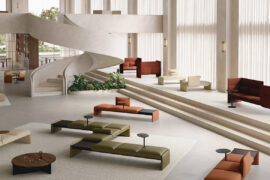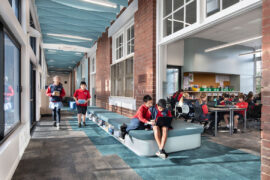Should we have to always rearrange our workstations every time to alleviate bad design? Maybe it’s about time that our products empower the end user!
Have you ever found yourself shifting about uncomfortably in your chair after just half an hour of responding to emails? How often have your clients embarked upon a reorganisation of their desks, even just so they can reach the phone or collaborate with one of their colleagues?
Forget about whether you can answer these questons, because the fact that they can even be asked indicates that the design-intent behind the vast majority of workstations clearly isn’t working as hard or efficiently as it should be. But this isn’t a moment when we need to throw our hands up in despair! In this day and age when, with so much literature available on workplace ergonomics and the importance of employee wellbeing, more and more manufacturers are realising the growing importance of used-centred design thinking.
Designing ‘for’ the end-user doesn’t necessarily mean designing a ultra comfortable desk. Rather, user-centred design seeks to create products that allow entire workstations to adapt to whatever task a user could/might/will perform and whatever myriad posture that would be adopted along the way – day in, day out. Of course, there are many furniture manufacturers that can make this claim today but there are very few who accomplish it as seamlessly, both visually and operationally, as American brand Humanscale.
Ever since day one back in 1983 Humanscale has been pioneering products that fit and flex around the end user for optimum comfort and performance, rather than the other way around. Just look at the company’s chairs, for example. Unlike most commercial furniture that shouts about being ‘flexible’, Humanscale’s signature is readily identifiable: a new frontier in user-adjustment that requires very few levers and knobs. By designing their products to be responsive to user dimensions, movement and needs, Humanscale encapsulates the strong belief that the highest level of functionality is achieved through simplicity and fitting the tools to the body rather than shoe-horning the body into the tools.
Instead of relying on the manual operation of a clunky mechanism, every piece in Humanscale’s seating portfolio automatically reads the weight of the user to provide the perfect recline with the correct tension for every individual, every task, every time. Not only does this ensure maximum comfort, it eliminates the (obscenely likely) scenario of someone setting the chair at the wrong height or angle – a very slippery slope leading to some rather distressing visits to the chiropractor.
Moreover, with most office chairs, the arms are typically attached to the seat, which means that when the user leans back or changes position, they lose this support. Humanscale, however, designs all of its chairs with the arms attached to the back so that when the user moves, the arms move with them and they are in a comfortable, ergonomically-accurate position.
“We believe the best designs are based on purpose and function, and if a design solves a functional problem as simply as elegantly as possible, the resulting form will have a beauty that is honest and timeless.” – Bob King, CEO of Humanscale.
This philosophy underpins everything the furniture stalwart designs and does. From its QuickStand height adjustable workstation, to its Element Disc LED task light and multi-purpose Ballo stool, every one of Humanscale’s products moves easily, freely and instantly to work with the user’s activity and posture.
Ideal for traditional workspaces or home offices as well as collaboration spaces and reception areas, the Ballo stool offers the ultimate in flexibility. An imaginative take on the exercise ball, it features a compact central column book-ended by air filled domes. Its counter weighted base helps the stool remain upright for stable movement and convenient storage whilst its lightweight design (just 13.5 pounds) means it can be easily transported around our increasingly agile offices, suiting those individuals and corporations extant in the currently voguish ‘gig economy’.




Just like an exercise ball, Ballo’s unique design language speaks to those who may suffer from poor posture or back issues. In fact, many end-users have subsequently reported a a notable increase in core strength. However, thanks to its clever design, it’s not quite as hard (or, indeed, exhausting!) work as an exercise ball and it can incorporate much more easily into commercial environments of various scale and processes.
Another recent addition to Humanscale’s seating portfolio is Trea designed by Todd Bracher, which draws on nature’s simplest structures to mimic the instinctive recline of the human body and embrace the sitter like a protective shell. Having recently made a big splash at Milan this year, Trea’s backrest gently pivots to follow the natural point of rotation at the hip and expand the surface of the chair to offer maximum comfort. Like all of the company’s designs, functionality is effortlessly infused into the piece for a simple, elegant finish that suits all settings.
https://vimeo.com/112294189
Studies show that comfortable employees are much happier and more productive, thus the ability to move about whilst working has never been so important. However, it’s not just the ability to move about so fluidly that makes Humanscale’s furniture some of the best received in the commercial world; it’s the fact that users can change activities without even having to think about it; without having to move everything else around them or deal with fiddly mechanisms. As people go from task to task, their entire workstation adapts – – moving so elegantly and seamlessly you hardly even notice.
INDESIGN is on instagram
Follow @indesignlive
A searchable and comprehensive guide for specifying leading products and their suppliers
Keep up to date with the latest and greatest from our industry BFF's!

The undeniable thread connecting Herman Miller and Knoll’s design legacies across the decades now finds its profound physical embodiment at MillerKnoll’s new Design Yard Archives.

Crafting form and creating function with rattan, Patrick Keane and Enter Projects Asia’s latest project is proving to be a draw card for shoppers at the dynamic fashion house Massimo Dutti.

Where style and substance truly dwell, Gardam’s latest modular collection – available through Stylecraft – balances elegance and versatility.
The internet never sleeps! Here's the stuff you might have missed

A multi-million dollar revitalisation of the heritage-listed venue at Brisbane’s beauty spot has been completed with The Summit Restaurant.

At Moonee Ponds Primary School, Clarke Hopkins Clarke’s transformative design uses Autex acoustic solutions to shape a calm and creatively charged learning environment.

At the NGV’s Making Good: Redesigning the Everyday, design becomes a force for repair. From algae-based vinyl to mycelium earplugs, the exhibition proves that rethinking the ordinary can reshape our collective future.